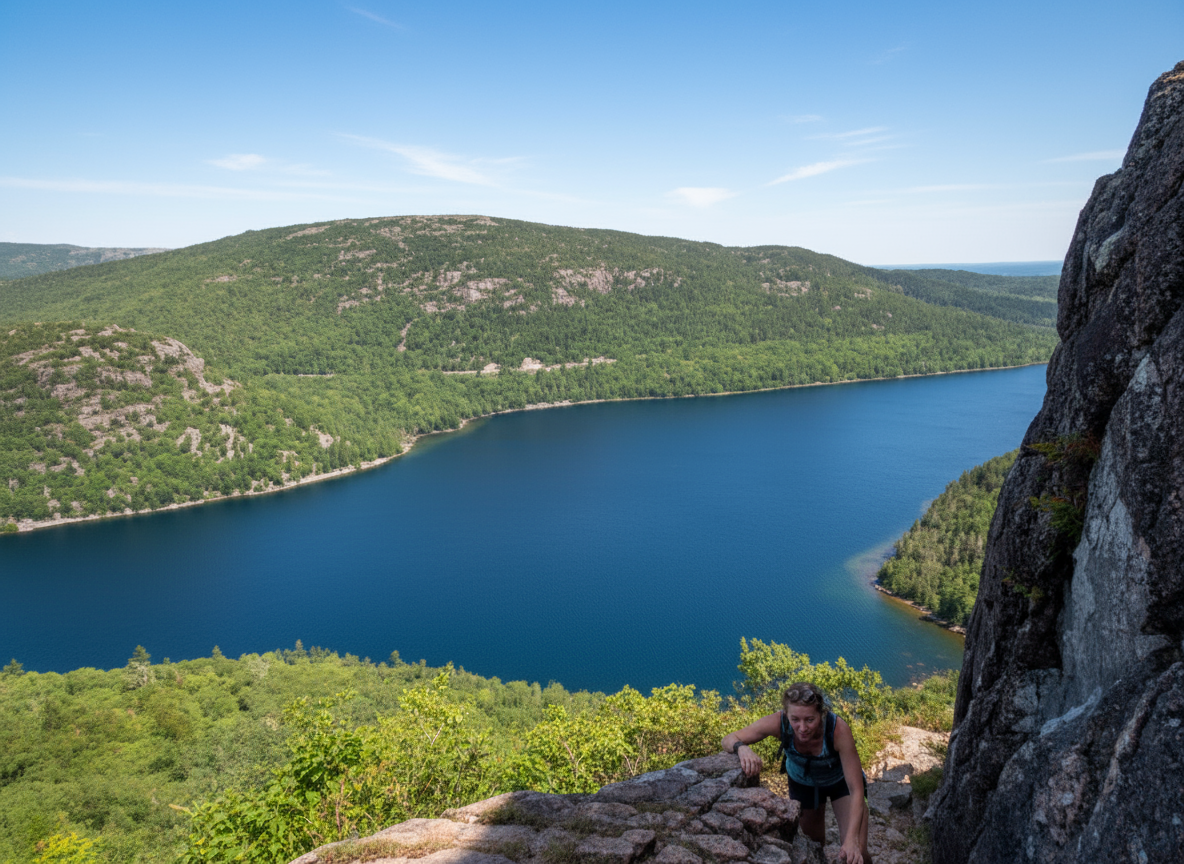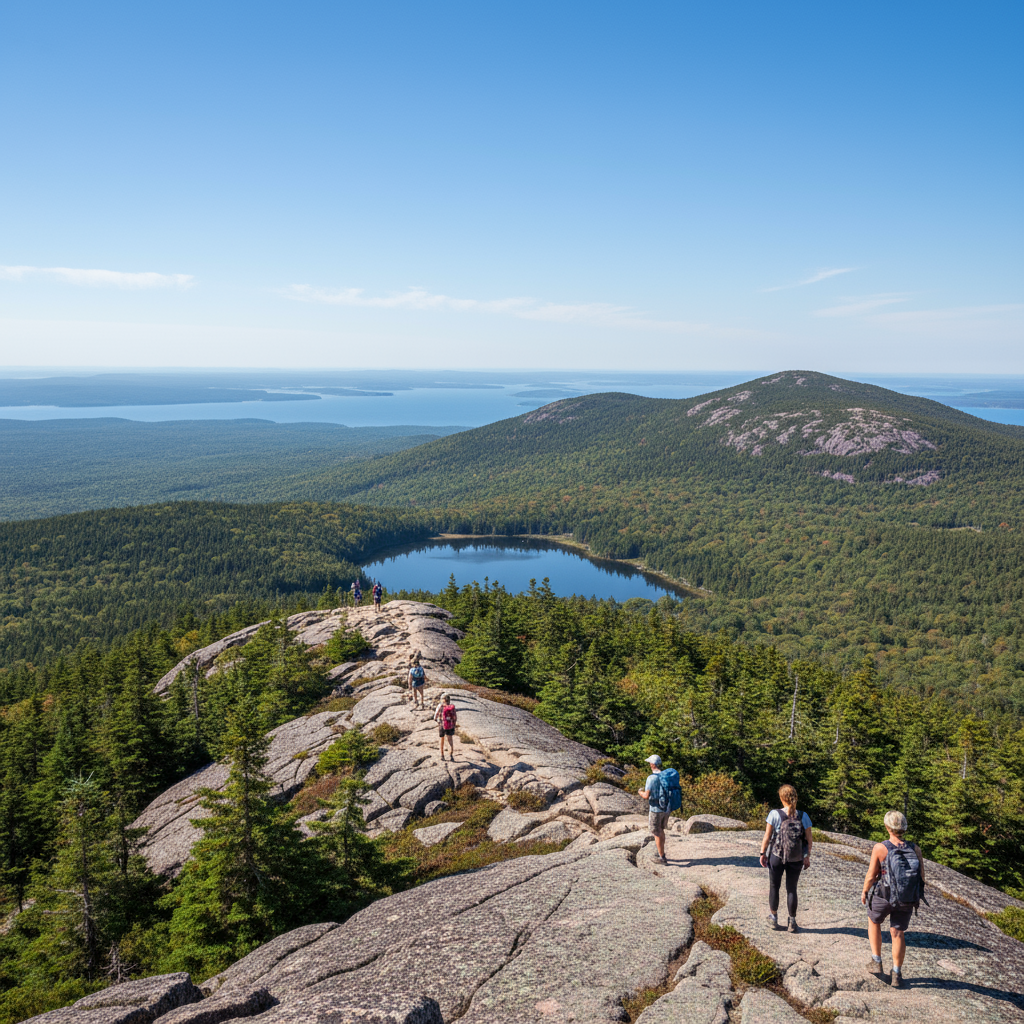Penobscot Mountain Acadia National Park
Trails, Summit Views, and Granite Ridge Adventures
Penobscot Mountain Acadia National Park rises to 1,194 feet above Jordan Pond, making it one of the most scenic and rewarding climbs in Acadia. The mountain blends shaded spruce-fir forest with open granite ridges, offering hikers a constantly changing experience as they ascend. From the summit, views stretch across Sargent Mountain, the Bubbles, Frenchman Bay, and the Atlantic horizon — rivaling Cadillac Mountain but with far fewer crowds.
Linked to several of Acadia’s most popular routes, Penobscot is also a hub for loop hikes. Adventurers can combine it with Sargent Mountain for a challenging full-day trek, follow the Jordan Cliffs Trail for a thrilling ledge walk, or return along the Jordan Pond Path for a gentler finish. Whether you’re after a direct climb or a long ridge circuit, Penobscot Mountain captures the rugged essence of Acadia.
Why Hike Penobscot Mountain Acadia National Park?
Penobscot Mountain in Acadia National Park is often described as one of the park’s most well-rounded hikes. Rising along a granite ridge, it offers sweeping views of Jordan Pond, the Atlantic Ocean, and the ridgelines that weave across Mount Desert Island. Unlike Cadillac, which welcomes visitors by car, or Beehive, which tempts thrill-seekers with iron rungs, Penobscot provides a quieter, steadier climb. It strikes a rare balance — enough challenge to leave you satisfied at the summit, but approachable enough for hikers who simply want to stretch themselves without feeling pushed to the edge.
Part of what makes Penobscot special is its setting. Nestled between Jordan Pond and neighboring Sargent Mountain, it naturally fits into one of Acadia’s most iconic loop hikes. In just a few hours, you can wander through cool forest paths, scramble across sun-warmed granite ledges, pause at shimmering pond overlooks, and emerge onto open summits where the ocean spreads endlessly beyond the horizon. Few trails in the park capture so many of Acadia’s signature landscapes in such a compact adventure.
For many, Penobscot also feels like the “just right” mountain. It offers the sense of exploration and accomplishment that hikers crave, without the intense exposure of Beehive or the heavy foot traffic of Cadillac. Families, couples, and solo adventurers alike find that it delivers a memorable experience no matter how you approach it. Whether you come to connect it with Sargent in a classic ridge-to-ridge journey, to stand above Jordan Pond with the Bubbles perfectly framed below, or simply to enjoy the broad granite dome at the top, Penobscot Mountain rewards every step with views and moments that stay with you long after you’ve left the trail.
Did You Know? — Penobscot Mountain (Acadia)
- Balanced challenge: Harder than Day Mountain, but less intimidating than Beehive or the summit scene on Cadillac.
- Classic loop: Often paired with nearby Sargent Mountain for one of Acadia’s signature ridge-to-ridge circuits.
- Blueberry ledges: In summer, wild lowbush blueberries pop up along Penobscot’s granite cracks.
- Iconic viewpoint: From the summit, Jordan Pond is perfectly framed by the North & South Bubbles.
- Historic trail craft: Sections feature early-1900s Bates-style stone steps designed to blend into the granite.
Penobscot Mountain Trails
For many visitors, the journey up Penobscot Mountain begins at the Jordan Pond House, a beloved Acadia landmark famous for its views and traditions. From here, hikers set out along the Jordan Pond Trail, a gentle lakeside path that soon branches upward into two classic approaches: the Spring Trail and the Jordan Cliffs Trail. Both climbs steadily gain elevation, carrying you from the calm shoreline into the rugged highlands that crown Penobscot’s ridgeline.
These routes highlight the contrasts that make Acadia so unique. Cool, shaded sections of spruce and fir forest provide relief before opening onto broad granite ledges, where sudden vistas stretch across Jordan Pond and toward the Atlantic beyond. Along the way, you’ll find cairns and Bates-style stone steps — carefully placed features that merge human trail design with the mountain’s natural rock, ensuring the climb feels both challenging and harmonious.
For those who prefer a more direct challenge, the Penobscot Mountain Trail runs straight from Jordan Pond to the summit. This path is steeper than the loop approaches, but it rewards almost immediately with constant views. Every switchback reveals another glimpse of the Bubbles, Jordan Pond, or the rolling ridges that form Acadia’s spine. Many hikers consider this one of the most scenic climbs in the entire park, thanks to the way it weaves views into every stage of the ascent.
Whether you choose the circuitous adventure of the Spring and Jordan Cliffs Trails or the straight-to-the-top efficiency of the Penobscot Mountain Trail, each path delivers a different angle on the same reward: a summit that feels earned, panoramic, and unforgettable.
Trail Tips — Penobscot Mountain
- Choose your path: Spring Trail is steady, Jordan Cliffs adds drama, and the direct Penobscot Mountain Trail rewards with constant views.
- Historic craftsmanship: Cairns and Bates-style steps guide hikers while blending seamlessly into the granite.
- Start at Jordan Pond: Most routes begin at the famous Jordan Pond House, making the hike easy to combine with a post-climb treat.
- Changing scenery: Expect quick shifts from shaded spruce-fir forest to bright, open ledges with sweeping vistas.
- Photography spots: The ascent offers natural ledges that frame Jordan Pond, the Bubbles, and even glimpses of Frenchman Bay.
The Classic Loop: Penobscot and Sargent Mountains
If there is one hike that captures the spirit of Acadia National Park in a single day, it’s the Penobscot–Sargent Mountain Loop. This celebrated circuit links two of the park’s most remarkable summits, blending variety, challenge, and reward in a way few trails can match. For many visitors, it stands as the ultimate Acadia hike — the one they talk about long after their boots have left the granite.
The adventure begins at the edge of Jordan Pond, one of the most iconic starting points in the park. From here, the trail winds gently at first, tracing the shoreline before climbing Penobscot’s southern ridge. The shift is gradual but dramatic: shaded forest soon gives way to sunlit granite ledges, where each turn offers wider and wilder views. Looking back, Jordan Pond glistens like a mirror, with the rounded Bubbles rising beyond. Looking outward, Frenchman Bay opens into the Atlantic, dotted with distant islands.
Reaching Penobscot’s summit is a reward in itself — a wide, open dome of granite that feels almost alpine despite the modest height. The air is often cool and breezy, carrying the cries of gulls from the coast and the rustle of spruce trees below. From here, the loop doesn’t end but instead grows richer. The ridgeline leads north toward Sargent Mountain, Acadia’s second-highest peak, and the sense of wilderness deepens with every step. This stretch is pure backcountry Acadia: expansive slabs of granite, cairns leading the way, and uninterrupted panoramas in all directions. On clear days, you can see Eagle Lake to the west, Frenchman Bay to the east, and the scattered islands of Maine’s coast glittering on the horizon.
As the trail dips from Sargent’s summit, hikers are often greeted by Sargent Mountain Pond — a small alpine tarn tucked high in the ridgeline. Its calm waters provide the perfect place to pause, rest weary legs, and take in the reflection of sky and rock on the surface. Some hikers consider this pond the secret highlight of the loop, a quiet counterpoint to the grandeur of the summits.
From here, the loop curves back toward Jordan Pond, gradually descending through forest and ledges until you return to where the journey began. By the end, hikers have experienced Acadia at its finest: summit ridges, pond reflections, sweeping ocean views, and the simple joy of linking two great peaks in one unforgettable trek.
Loop Highlights — Penobscot & Sargent
- Two summits in one: Combine Penobscot and Sargent for one of Acadia’s most rewarding ridge-line adventures.
- Alpine feel: Despite modest elevation, the open granite ridges give the hike an alpine character with sweeping panoramas.
- Sargent Mountain Pond: A small alpine tarn tucked between ridges provides a peaceful mid-hike rest stop.
- Varied views: From Jordan Pond to Frenchman Bay, the loop delivers constant changes in scenery.
- Classic status: This loop is often ranked among Acadia’s finest hikes for its balance of challenge and beauty.
Summit Views from Penobscot Mountain
Reaching the summit of Penobscot Mountain feels like stepping onto the roof of Acadia. The climb, steady but never overwhelming, suddenly gives way to wide-open granite ledges that seem to stretch endlessly in every direction. It’s here that the landscape unfolds in layers — water, forest, rock, and sky blending together in a panorama that feels larger than the mountain itself.
To the east, Frenchman Bay sparkles like a sheet of glass, its surface broken by a scattering of islands and, on summer days, the faint white triangles of sailboats drifting in the distance. Beyond the bay, the open Atlantic takes over, its horizon so vast and seamless that sky and sea often blur together in shades of blue.
Turn south, and Jordan Pond commands attention. Long and slender, it mirrors the sky with almost perfect clarity, framed at its northern end by the twin domes of the North and South Bubbles. This iconic view is one of the most photographed in the park, but from Penobscot’s summit, it feels uniquely your own — a perspective that combines intimacy with grandeur.
To the west, the eye follows the rolling ridges of Mount Desert Island, where spruce forests rise and fall across the granite backbone of Acadia. Peaks like Sargent and Dorr appear close enough to touch, while further still, Eagle Lake glimmers in the distance. On crisp, clear days, the views extend so far that visitors often remark they can see forever.
What makes Penobscot special isn’t only the views, but the space to enjoy them. Unlike the crowded summit of Cadillac, Penobscot’s broad granite dome offers plenty of room to spread out. Some visitors find a quiet ledge to sketch the landscape; others lay back on the warm stone, picnic at the edge, or simply close their eyes and listen to the breeze moving across the ridge. It’s a summit that feels both commanding and comfortable — a place where effort and reward strike the perfect balance.
Many hikers call it one of the most satisfying outlooks in Acadia, not because it is the highest or the hardest, but because it delivers a complete experience: a challenging yet accessible climb, an expansive summit with room to linger, and views that capture the very essence of Mount Desert Island. On Penobscot’s summit, the world doesn’t just open wide — it invites you to stay awhile.
Viewpoints — Penobscot Mountain Summit
- Jordan Pond framed: From the summit, the North & South Bubbles perfectly frame the pond below.
- Ocean horizon: On clear days, the view extends beyond Mount Desert Island to the Atlantic itself.
- Frenchman Bay: Islands and sailboats often sparkle to the east, adding depth to the panorama.
- Room to linger: The summit’s broad granite ledges give plenty of space for resting or picnicking.
- A balanced outlook: Though lower than Cadillac, many describe Penobscot’s views as more satisfying thanks to the mix of ridges, ponds, and ocean.
Sunrise and Sunset on Penobscot Mountain
While Cadillac Mountain claims fame as one of the first places in the U.S. to see the sun, Penobscot Mountain quietly delivers an experience that many find even more rewarding. Without the crowds that gather shoulder-to-shoulder on Cadillac, sunrise here feels personal — almost private. As the first hints of light touch the horizon, Frenchman Bay begins to shimmer, its islands outlined in soft blush tones. The granite underfoot catches the glow, shifting from cool gray to pale rose, while the air feels fresh and still. Early risers often find themselves alone or with only a handful of others, listening as birds awaken and the park slowly stirs to life.
By evening, Penobscot transforms again. As the sun lowers toward the western ridges, the granite dome of the summit bathes in golden light. The long shadows accentuate every crack and ledge, while the forests below take on deeper greens and purples. Jordan Pond, resting at the mountain’s base, becomes a luminous mirror — perfectly reflecting the sky’s amber, crimson, and violet hues. The rounded silhouettes of the North and South Bubbles stand proudly in the distance, glowing with warmth as the day draws to a close.
This is where Penobscot’s charm shines: while Cadillac can feel like a performance with a captive audience, Penobscot offers space and solitude. You can stretch out on a sun-warmed ledge, set up a camera without jostling for position, or simply sit quietly and absorb the atmosphere as the day begins or ends. The quiet is broken only by the breeze sweeping across the granite, or the soft laughter of a few fellow hikers savoring the same view.
For photographers, golden hour on Penobscot Mountain provides endless possibilities. At dawn, the pastel palette over Frenchman Bay highlights every island and creates compositions filled with subtle beauty. At sunset, the combination of granite ridges, reflected light on Jordan Pond, and the glowing Bubbles provides a scene that rivals anything in the park. With patience, the shifting light rewards you with moments that feel fleeting and timeless all at once.
In both directions, sunrise and sunset at Penobscot embody what makes Acadia so beloved — not only the scenery, but the feeling of connection. Here, the day doesn’t just begin or end; it unfolds in colors and textures that remind you how wild and peaceful this corner of Maine truly is.
Golden Hour Highlights — Penobscot Mountain
- Peaceful sunrise: Unlike Cadillac, Penobscot’s dawn views are quieter, with light spilling gently across Frenchman Bay.
- Reflective sunset: By evening, Jordan Pond mirrors the fading glow while western ridges turn amber.
- Photographer’s dream: The changing light paints the Bubbles and pond in soft pastels at sunrise, and warm golds at dusk.
- Less crowded: Golden hour here often feels personal, away from the sunrise crowds atop Cadillac.
- Atmospheric skies: Clear evenings reveal dramatic shifts from pink to violet across Acadia’s skyline.
Wildlife & Conservation on Penobscot
Penobscot Mountain is not only a place of sweeping panoramas but also a living landscape, alive with subtle wildlife and shaped by careful stewardship. Along the shaded lower slopes, the spruce-fir forest rings with birdsong. Warblers flash through the treetops, thrushes call in flute-like notes that echo off the ridges, and black-capped chickadees dart close by, fearless and inquisitive. On the forest floor, red squirrels scurry noisily, pausing only to chatter indignantly at hikers who pass beneath their branches. As the seasons shift, so too does the life of the mountain: in summer, the granite ledges come alive with lowbush blueberries, drawing in not only birds and squirrels but also hikers eager to sample Acadia’s sweetest trail-side surprise.
These living details are part of a broader conservation story that defines Penobscot’s place within Acadia National Park. Trails here have been laid out with intention, balancing access with protection. Cairns — carefully stacked stone markers placed along the granite — guide hikers across the open ridges. They may look simple, but they are a thoughtful solution: subtle, durable, and in harmony with the mountain itself. More than navigational aids, these cairns stand as symbols of Acadia’s dedication to low-impact design, reminding visitors that even a well-worn trail can respect the wilderness it traverses.
The landscape here is surprisingly fragile. The thin pockets of soil nestled between granite slabs host mosses, lichens, and delicate alpine plants that can take decades to recover from a single misplaced step. That is why following the cairns and keeping to the designated path is so important. Every footstep on the right line helps preserve the green patches that give Penobscot its quiet character. In this way, each visitor becomes part of Acadia’s conservation effort — helping ensure that the wildlife, the blueberries, and the intricate plant communities endure for the next generation of hikers to discover.
Nature Notes — Penobscot Mountain
- Songbird haven: Warblers, thrushes, and chickadees flit through the spruce-fir woods along the trails.
- Squirrel chatter: Red squirrels are often heard before they’re seen, scolding hikers from the branches.
- Blueberry ledges: In summer, lowbush blueberries dot the granite cracks, feeding both hikers and wildlife.
- Conservation focus: Trails are maintained to balance visitor access with fragile alpine-like ecosystems.
- Cairns with care: Stone cairns guide hikers across open ledges, reminders to stay on route and protect delicate vegetation.
Photography on Penobscot Mountain
Penobscot Mountain is often described by photographers as one of Acadia’s most rewarding peaks, not because it towers over the park, but because of the endless variety it offers behind the lens. The summit delivers sweeping panoramas, where a wide-angle lens can perfectly frame Jordan Pond and the rounded Bubbles, with Frenchman Bay and the Atlantic glimmering in the distance. Midway up, the granite ledges become natural stages for layered compositions: cracked pink stone in the foreground, spruce ridges rolling into the horizon, and cloudscapes that change with every passing breeze.
The mountain is also a study in seasons, each one painting its own palette. Spring softens the views with pale greens, misty mornings, and the first wildflowers pushing through the cracks in the granite. Summer heightens the drama — skies sharpen to deep cobalt, Jordan Pond reflects perfectly under midday light, and the air is so clear that distant islands seem close enough to touch. Autumn transforms everything into a blaze of red, orange, and gold, the Bubbles glowing in warm light above Jordan Pond’s mirrored surface. Winter strips the scene down to its bones, when snow dusts the ledges and ice seals the pond, creating stark black-and-white contrasts that appeal to those who love minimalist compositions.
Perhaps what makes Penobscot truly stand out for photographers is its atmosphere. Unlike Cadillac, where sunrise can feel like a crowded performance, Penobscot offers quiet space to work. There’s time to set up a tripod without hurry, to wait for clouds to shift or for light to skim across the granite, and to explore angles that others overlook. A single hike might yield intimate details — blueberries clinging to the ledges, lichens painting the rock in subtle colors, or a chickadee caught in perfect focus — alongside grand, sweeping landscapes that capture the scale of Acadia itself.
For many, photographing Penobscot feels less like chasing a shot and more like entering a living gallery. Every turn of the trail offers a new composition: cairns against dramatic skies, ridgelines receding into mist, or Jordan Pond glowing at golden hour. It’s a place where patience is rewarded and where the act of slowing down with a camera becomes part of the mountain’s rhythm.
Photo Tips — Penobscot Mountain
- Summit angles: Wide shots from the granite dome frame Jordan Pond perfectly with the Bubbles behind.
- Seasonal colors: Spring greens, summer blues, autumn reds, and winter whites all offer unique moods.
- Foreground drama: Use granite ledges or cairns to add depth and scale to panoramic shots.
- Golden hour glow: Sunrise and sunset soften the ridges and create pastel tones across Frenchman Bay.
- Less crowded: Compared to Cadillac, fewer visitors mean more time to set up shots without interruption.
Accessibility & Visitor Tips
Penobscot Mountain is a rewarding destination, but it pays to be prepared before setting out. With a little planning, your hike can be both safe and memorable.
- Parking: Most visitors start their hike from the Jordan Pond House area, one of Acadia’s most popular hubs. Parking here is limited and fills very quickly in summer — often by mid-morning. Arriving early gives you the best chance at a spot and lets you enjoy the first part of the hike in cooler air. If parking is unavailable, the Island Explorer Shuttle is a stress-free alternative that connects directly to Jordan Pond and saves you the hassle of circling for spaces.
- Trail Difficulty: Penobscot offers several approaches, ranging from moderate to strenuous. Trails like the Spring Trail and Jordan Cliffs Trail involve steady climbing, narrow ledges, and stretches across open granite, rewarding hikers with views at nearly every turn. The Penobscot Mountain Trail is steeper but more direct, appealing to those who prefer a straightforward route. No matter the path, sturdy shoes with good grip, layered clothing, and enough water are essentials for the climb.
- Best season: Hiking Penobscot is most enjoyable from late spring through fall. Spring brings refreshing cool breezes and vibrant new growth, summer provides long daylight hours and sweeping views over sparkling waters, while autumn turns the ridges into a canvas of fiery foliage. Winter ascents are possible but require preparation for icy granite, cold winds, and shorter daylight hours — conditions best suited to seasoned hikers.
- Family suitability: Though more demanding than easier climbs like Day Mountain, Penobscot remains accessible to older children and families with hiking experience. The variety of terrain — shaded forest paths, stone steps, and wide ledges — helps keep younger hikers engaged, while the panoramic views at the top provide an unforgettable reward. With proper pacing and breaks, even families can enjoy the adventure without it feeling overwhelming.
- Photography opportunities: Penobscot is a dream for photographers. The climb offers countless vantage points for capturing Jordan Pond framed by the Bubbles, dramatic cloudscapes rolling over ridgelines, or the play of light at sunrise and sunset. Because it’s less crowded than Cadillac, photographers often have the luxury of time and space to set up their shots without distraction, making it one of Acadia’s most rewarding peaks to photograph.
With the right preparation, Penobscot Mountain offers one of the most balanced hiking experiences in Acadia — challenging but not overwhelming, scenic but not overcrowded. Whether you’re a family, a seasoned hiker, or a photographer chasing golden light, this peak provides both adventure and peace in equal measure.
Visitor Tips — Penobscot Mountain
- Arrive early: Parking at Jordan Pond House fills quickly in peak summer — early mornings mean easier access and cooler air.
- Shuttle option: The Island Explorer bus stops at Jordan Pond, making it a stress-free alternative to driving.
- Pack smart: Good footwear, layered clothing, and plenty of water are essential for this moderate-to-strenuous climb.
- Best season: Trails are clearest from late spring to fall, with autumn foliage adding extra beauty.
- Family-friendly: Older children and families used to hiking will find the climb manageable and rewarding.
Getting to Penobscot Mountain
Penobscot Mountain is one of Acadia’s most accessible peaks, with a trail system that begins at one of the park’s most famous gathering spots. The most direct route starts at Jordan Pond House, a historic visitor hub where generations of hikers have paused for tea and popovers before venturing onto the trails. From Bar Harbor, the drive is short and scenic, following the Park Loop Road past woodlands, lakes, and coastal overlooks before arriving at Jordan Pond. Even before you set foot on the mountain, the journey feels like part of the experience.
During peak summer months, parking at Jordan Pond can be a challenge, as lots often fill by mid-morning. To avoid the stress of circling for a space, many visitors choose the Island Explorer Shuttle, a seasonal and eco-friendly bus service that stops directly at Jordan Pond. The shuttle connects Bar Harbor with many of the park’s popular destinations and provides a simple, car-free way to reach the trailhead. For families or groups, it’s a convenient alternative that lets everyone begin the hike together, free from parking worries.
Once you arrive at Jordan Pond House, finding the right trail is straightforward. Signage points hikers toward the Spring Trail, Jordan Cliffs Trail, or Penobscot Mountain Trail, each offering a slightly different approach. The Spring Trail provides a steady climb through spruce-fir forest, the Jordan Cliffs Trail adds exposure and drama, and the Penobscot Mountain Trail offers a more direct, view-filled ascent. No matter which you choose, the transition is striking — within minutes of leaving the cultivated lawn and tea tables, you are immersed in the quiet of the woods, with the granite backbone of Acadia underfoot.
For many, this easy access is part of Penobscot’s charm: a mountain that begins with a gentle stroll from a historic lawn and quickly unfolds into a backcountry adventure of ridges, ledges, and wide-open views.
Access Tips — Penobscot Mountain
- Start at Jordan Pond House: The trailhead is just steps from Acadia’s most famous popover stop.
- Easy drive: From Bar Harbor, follow the Park Loop Road — a short, scenic trip with overlooks along the way.
- Shuttle option: The Island Explorer bus stops right at Jordan Pond, ideal in summer when parking fills fast.
- Clear signage: Trails are well marked with signs pointing toward Spring, Jordan Cliffs, and Penobscot Mountain routes.
- Quick transition: Within minutes of leaving the lawn, you’re immersed in spruce forest and granite ridges.
Wrapping Up Your Penobscot Mountain Visit
Penobscot Mountain in Acadia National Park may not command the instant recognition of Cadillac or the adrenaline-fueled thrill of Beehive, yet it quietly offers something just as compelling — perhaps more so. It is a mountain of balance: strenuous without being punishing, dramatic without being overwhelming, scenic without being crowded. From its sun-warmed granite ridges, hikers can gaze down at Jordan Pond glimmering in the valley, see the rounded profiles of the Bubbles, and follow their sightlines all the way out to the Atlantic Ocean. Few places in Acadia bring so many of the park’s classic features together in one panorama.
Hiking Penobscot feels like stepping into a layered story. The approach through spruce-fir woods offers shade and calm before spilling onto open ledges where cairns guide you higher. Each step upward adds new views — ponds tucked among the ridges, sails gliding across Frenchman Bay, blueberries dotting the granite in summer, and autumn colors burning across the forest canopy. At the summit, the broad, welcoming ledges invite you to linger, to sit down, and let the breeze carry away the effort of the climb.
For those linking Penobscot with Sargent Mountain in the classic loop, the experience deepens further. Together, the two summits deliver a circuit of sweeping ridgelines and quiet tarns that feels alpine in spirit, even at modest elevations. It’s an adventure that leaves hikers both exhilarated and restored, a rare blend of challenge and tranquility.
Penobscot may not boast the tallest peak or the most famous trail, but it leaves its mark in subtler, lasting ways. It’s the kind of hike that stays with you — in the way light danced on the water, in the silence of the forest trail, in the feeling of standing above Jordan Pond with the Bubbles perfectly framed below. More than just a climb, Penobscot offers an invitation: to slow down, to notice, and to carry its peace with you long after you’ve left its summit.
As you finish exploring Penobscot Mountain, remember that Acadia’s peaks each bring their own rewards. Ready for your next adventure?
Back to Mountains in AcadiaFurther Reading
Don’t Miss Out
Every month we share trail tips, hidden gems, and stunning photos from Acadia and beyond. Join fellow park lovers and get the inside scoop before your next adventure!
Sign Up










